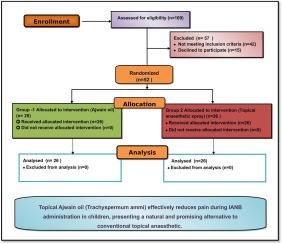局部阿瓦因油在减轻小儿牙科患者局部麻醉时疼痛的有效性:一项随机对照试验
Q1 Medicine
Journal of oral biology and craniofacial research
Pub Date : 2025-09-06
DOI:10.1016/j.jobcr.2025.09.008
引用次数: 0
摘要
背景:针头焦虑是为儿童提供无压力牙科护理的最常见障碍之一。在儿科牙科,有一个一致的努力,以确定无痛的技术进行局部麻醉。长期以来,局部麻醉一直被认为是这方面有价值的援助。近年来,人们比较了草药表面麻醉剂与常规喷雾剂和凝胶剂的麻醉效果。目前的研究是第一个评估在小儿牙科患者局部麻醉期间,石蜡油作为局部药物控制疼痛的有效性。目的评价和比较Ajwain (Trachyspermum ammi)油与传统的15% w/w利多卡因局部喷雾剂在小儿牙科患者局部麻醉时减轻疼痛感觉的镇痛效果。方法采用chit法将52例符合纳入和排除标准的6 ~ 10岁儿童随机分为两组(1组:阿吉瓦因油;2组:表面麻醉喷雾)。采用视觉模拟量表(VAS)和Wong-Baker面部疼痛评定量表(WBFPRS)评估疼痛反应。结果独立t检验显示,组1和组2在VAS和WBFPRS评分上均有统计学差异,每个量表的p值均为0.001,表明ajain油组疼痛感知显著降低。结论印度甘油三酯油可有效替代传统的局部麻醉喷雾剂,减轻小儿齿科患者的注射痛。本文章由计算机程序翻译,如有差异,请以英文原文为准。

Effectiveness of topical ajwain oil in reducing pain during local anaesthesia administration in paediatric dental patients: A randomized controlled trial
Background
Needle anxiety is one of the most common barriers to providing stress-free dental care in children. In paediatric dentistry, there is a consistent effort to identify painless techniques for administering local anaesthesia. Topical anaesthetics have long been considered a valuable aid in this regard. Recently, the efficacy of herbal topical anaesthetic agents has been compared with that of conventional sprays and gels. The present study is among the first to evaluate the effectiveness of Trachyspermum ammi (Ajwain) oil as a topical agent for pain control during local anaesthesia administration in paediatric dental patients.
Objective
The objective of this study was to evaluate and compare the analgesic efficacy of Ajwain (Trachyspermum ammi) oil with a conventional 15 % w/w lidocaine topical spray in reducing pain perception during the administration of local anaesthesia in paediatric dental patients.
Methods
A total of 52 children, aged 6–10 years and meeting the inclusion and exclusion criteria, were randomly divided into two equal groups (Group 1: Ajwain oil; Group 2: topical anaesthetic spray) using the chit method. Pain responses were assessed using the Visual Analogue Scale (VAS) and the Wong-Baker Facial Pain Rating Scale (WBFPRS).
Results
Independent t-tests revealed statistically significant differences between Group 1 and Group 2 for both VAS and WBFPRS scores, with p values of 0.001 for each scale, indicating a significant reduction in pain perception in the Ajwain oil group.
Conclusion
Ajwain oil shows potential as an effective alternative to conventional topical anaesthetic sprays for reducing injection pain in paediatric dental patients.
求助全文
通过发布文献求助,成功后即可免费获取论文全文。
去求助
来源期刊

Journal of oral biology and craniofacial research
Medicine-Otorhinolaryngology
CiteScore
4.90
自引率
0.00%
发文量
133
审稿时长
167 days
期刊介绍:
Journal of Oral Biology and Craniofacial Research (JOBCR)is the official journal of the Craniofacial Research Foundation (CRF). The journal aims to provide a common platform for both clinical and translational research and to promote interdisciplinary sciences in craniofacial region. JOBCR publishes content that includes diseases, injuries and defects in the head, neck, face, jaws and the hard and soft tissues of the mouth and jaws and face region; diagnosis and medical management of diseases specific to the orofacial tissues and of oral manifestations of systemic diseases; studies on identifying populations at risk of oral disease or in need of specific care, and comparing regional, environmental, social, and access similarities and differences in dental care between populations; diseases of the mouth and related structures like salivary glands, temporomandibular joints, facial muscles and perioral skin; biomedical engineering, tissue engineering and stem cells. The journal publishes reviews, commentaries, peer-reviewed original research articles, short communication, and case reports.
 求助内容:
求助内容: 应助结果提醒方式:
应助结果提醒方式:


